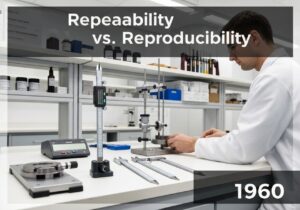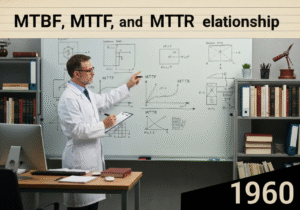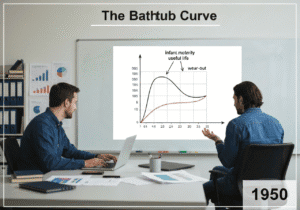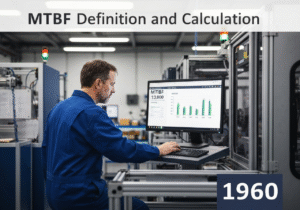To assess the amount of variation in a measurement system that is due to the measurement device itself (repeatability) and the operators using the device (reproducibility).
- Methodologies: Customers & Marketing, Economics, Product Design
Gage R&R (Repeatability and Reproducibility)

Gage R&R (Repeatability and Reproducibility)
- Continuous Improvement, Design for Six Sigma (DfSS), Process Capability, Process Improvement, Quality Assurance, Quality Control, Statistical Analysis
Objective:
How it’s used:
- Multiple operators measure the same parts multiple times using the same gage. Statistical analysis is then performed to determine the percentage of total process variation attributable to the measurement system.
Pros
- Helps ensure that measurement data is reliable and trustworthy; identifies sources of measurement error; essential for effective process control and improvement.
Cons
- Can be time-consuming to conduct properly; requires careful planning and execution; interpretation of results requires statistical understanding.
Categories:
- Lean Sigma, Manufacturing, Quality
Best for:
- Evaluating the precision and reliability of a measurement system.
Gage R&R studies are widely implemented across various industries such as manufacturing, automotive, aerospace, and healthcare, where consistent and accurate measurements are paramount for quality control and assurance. This methodology is particularly applicable during the early stages of product development, pilot production runs, and ongoing quality monitoring. Participants typically include quality engineers, process engineers, and operators who utilize measurement systems to assess critical dimensions and performance metrics of components. By conducting experiments where multiple operators measure the same parts using a designated gage under similar conditions, organizations can determine the extent of variability that can be attributed to the measurement system itself, as well as to operator variability. In automotive manufacturing, for instance, Gage R&R assessments help to ensure that measurements of component specifications align with safety and performance standards, thereby avoiding costly defects and recalls. Data obtained from statistical analysis enables teams to pinpoint specific sources of variability, whether they stem from equipment calibration issues or operator technique differences. This knowledge informs decisions regarding training needs for personnel, adjustments in measurement procedures, or enhancements in measurement equipment, thereby leading to more reliable processes. Regular application of Gage R&R studies can reinforce a company’s commitment to maintaining high-quality manufacturing standards and facilitate continual improvement initiatives within quality management systems such as ISO 9001 or Six Sigma methodologies.
Key steps of this methodology
- Select measurement parts and ensure they represent the variation within the population.
- Train operators on the measurement procedure to maintain consistency.
- Have multiple operators measure the same parts multiple times using the same gage.
- Randomize the order of measurements to minimize bias.
- Calculate the variability components from the measurement data.
- Analyze the data using statistical methods, such as ANOVA or equivalent techniques.
- Determine the percentage of total process variation attributed to the measurement system.
- Evaluate and document whether the measurement system is adequate for the intended use.
- Identify and analyze sources of measurement error to improve the system.
Pro Tips
- Utilize control charts to monitor and visualize variation over time and operator performance during the Gage R&R study.
- Incorporate training sessions for operators before conducting Gage R&R studies to ensure consistency in measurement techniques and interpretations.
- Perform a multidimensional analysis that includes factor interactions in your statistical evaluation to identify nuanced sources of measurement variation.
To read and compare several methodologies, we recommend the
> Extensive Methodologies Repository <
together with the 400+ other methodologies.
Your comments on this methodology or additional info are welcome on the comment section below ↓ , so as any engineering-related ideas or links.
Historical Context
1950
1950
1959-11
1960
1960
1960
1961
1950
1950
1950
1960
1960
1960
1960
1963
(if date is unknown or not relevant, e.g. "fluid mechanics", a rounded estimation of its notable emergence is provided)














Related Posts
Musculoskeletal Discomfort Questionnaires
Multivariate Testing (MVT)
Multiple Regression Analysis
Motion Capture Systems
MoSCoW Method
Mood’s Median Test